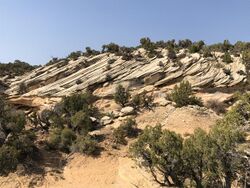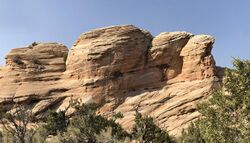Earth:Nugget Sandstone
From HandWiki
Short description: Geologic Formation in the United States
| Nugget Sandstone Stratigraphic range: Norian-Toarcian ~220–180 Ma | |
|---|---|
 Salmon-pink and white sandstones of the upper part of the Nugget Formation, Wind River Mountains, Wyoming | |
| Type | Geological formation |
| Unit of | Glen Canyon Group |
| Underlies | Carmel Formation |
| Overlies | Chinle Formation |
| Thickness | 200 m (660 ft) |
| Lithology | |
| Primary | Sandstone |
| Other | Mudstone, siltstone |
| Location | |
| Coordinates | [ ⚑ ] : 40°24′N 109°18′W / 40.4°N 109.3°W |
| Paleocoordinates | [ ⚑ ] 27°24′N 46°36′W / 27.4°N 46.6°W |
| Region | Colorado, Idaho, Utah |
| Country | |
| Extent | Colorado Plateau |
The Nugget Sandstone is a Late Triassic to Early Jurassic geologic formation that outcrops in Colorado, Idaho, Wyoming, and Utah, western United States .
In Wyoming, it is composed of a lower hematite-stained siltstone and thin-bedded sandstone. The upper part is a salmon-pink and light-gray, fine- to medium-grained cliff-forming sandstone that exhibits massive bedding to large scale cross-beds of dunes. Thickness ranges up to 86.9 m (285 feet).[1]
Fossil theropod tracks have been reported from the formation.[2]
Fossil content
Intermediate theropod, sphenosuchian, drepanosaurid and sphenodontian remains are known.[3]
| Paleofauna reported from the Nugget Sandstone | ||||||
|---|---|---|---|---|---|---|
| Genus | Species | Material | Notes | Images | ||
| Caelestiventus[4] | C. hanseni | Most of the skull, a complete lower jaw, a finger bone | A dimorphodontid pterosaur, the first known diagnostic pterosaur in North America. | |||
- Other fossils
Ichnofossils
- Batrachopus sp.
- Brachychirotherium sp.
- Brasilichnium sp.
- Cochlichnus sp.
- Diplichnites sp.
- Grallator (Eubrontes)
- Gwyneddichnium sp.
- Octopodichnus sp.
- Otozoum sp.
- cf. Paleohelcura sp.
- Pterichnus sp.
- Scoyenia sp.
- Treptichnus sp.
- ?Acanthichnus sp.
- ?Apatopus sp.
See also
- List of pterosaur-bearing stratigraphic units
- List of dinosaur-bearing rock formations
- List of stratigraphic units with theropod tracks
References
- ↑ Johnson, J.F. and Sutherland, W.M., 2009, Geologic map of the Lander 30' x 60' quadrangle, Fremont County, Wyoming, Wyoming State Geological Survey, Map Series MS-87, 1:100,000.
- ↑ Weishampel, et al. (2004). "Dinosaur distribution." Pp. 517-607.
- ↑ B. B. Britt, D. J. Chure, G. F. Engelmann and J. D. Shumway. 2016. Rise of the erg—paleontology and paleoenvironments of the Triassic-Jurassic transition in northeastern Utah. Geology of the Intermountain West 3:1-32
- ↑ Brooks B. Britt; Fabio M. Dalla Vecchia; Daniel J. Chure; George F. Engelmann; Michael F. Whiting; Rodney D. Scheetz (2018). "Caelestiventus hanseni gen. et sp. nov. extends the desert-dwelling pterosaur record back 65 million years". Nature Ecology & Evolution 2 (9): 1386–1392. doi:10.1038/s41559-018-0627-y. PMID 30104753.
Bibliography
- Weishampel, David B.; Dodson, Peter; and Osmólska, Halszka (eds.): The Dinosauria, 2nd, Berkeley: University of California Press. 861 pp. ISBN:0-520-24209-2
Further reading
- Lockley, M. G.; Tedrow, A. R.; Chamberlain, K. C.; Minter, N. J.; Lim, J.-D. (2011). "Footprints and invertebrate traces from a new site in the Nugget Sandstone (Lower Jurassic) of Idaho: implications for life in the northern reaches of the great Navajo-Nugget erg system in the western USA". Fossil Record 3. New Mexico Museum of Natural History and Science Bulletin 53: 344–356. https://econtent.unm.edu/digital/collection/bulletins/id/1425/rec/2.
- Lockley, M. G. (2011). "Theropod- and prosauropod-dominated ichnofaunas from the Navajo-Nugget Sandstone (Lower Jurassic) at Dinosaur National Monument: implications for prosauropod behaviour and ecology". Fossil Record 3. New Mexico Museum of Natural History and Science Bulletin 53: 316–320. https://econtent.unm.edu/digital/collection/bulletins/id/1421/rec/2.
- Lockley, M. G. (1986). "A Guide to Dinosaur Tracksites of the Colorado Plateau and American Southwest". University of Colorado at Denver Geology Department Magazine Special Issue 1: 1–56.
 |






